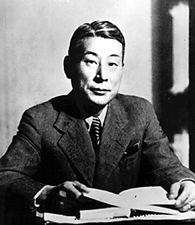Chiune Sugihara was a Japanese consul during World War II who helped save the lives of thousands of Polish Jewish refugees by signing visas that allowed them to flee the Nazis’ grasp.
Chiune Sugihara’s Early Days
Chiune Sugihara, also known as Sempo Sugihara, was born in Yaotsu in the Gifu Prefecture of Japan’s main island of Honshu, on January 1, 1900, to a middle-class samurai family. His father instilled the stringent samurai code of loyalty and obedience in his son and wanted him to become a doctor. But Sugihara sought an artistic life that would allow him to see the world.
Sugihara was educated at Waseda University. After graduating, he joined the Foreign Service and attended Harbin Gakuin, a school in China where he learned Russian and became an expert on the Soviet Union. He was appointed foreign ministry director of Manchukuo, a Japanese puppet state in Manchuria, and according to the United States Holocaust Memorial Museum encyclopedia, “negotiated the purchase of the North Manchurian railroad from the Soviet Union in 1932.”
Sources in this Story
- Jewish Virtual Library: Chiune and Yukiko Sugihara
- United States Holocaust Memorial Museum: Chiune (Sempo) Sugihara
- The Free Library: After 50 years Japan finally recognizes the actions of Chiune Sugihara, who is called “The Japanese Schindler”
- Ministry of Foreign Affairs of Japan: Story of a courageous diplomat of humanity, Mr. Chiune Sugihara
- YouTube: Japanese Holocaust Rescuer: Chiune ‘Sempo’ Sugihara
Notable Accomplishments
In 1939 Sugihara, now a convert to the Eastern Orthodox church, was sent to Lithuania’s temporary capital Kaunas, or Kovno, to open a consulate. Lithuania was allied with Germany then, and Kaunas was home to some 30,000 Jews—a quarter of the population. After the Nazis invaded Poland, Polish Jews began fleeing to Lithuania. Although Lithuanian Jews were not allowed to leave, Polish Jews could escape Nazi persecution if granted visas out of Lithuania.
On July 27, 1940, hundreds came to the Japanese embassy in Kaunas, pleading for transit visas. Sugihara wired the Japanese government three times, asking them to grant the visas. The government denied the request twice and did not respond to the third request. Sugihara and his wife, Yukiko then took matters into their own hands, signing more than 2,000 visas for 30 days straight. Because many of the survivors went on to have children, approximately 40,000 people owe their lives to the Sugiharas.
The Rest of the Story
Sugihara, who had once before shown similar compassion by aiding victims of a flood in Harbin, China, was not recognized for his efforts initially. He was transferred to Prague soon after the visa event, and then to Romania, where the Soviets arrested him in 1944. Released three years later, he returned to Japan, and was fired from the Foreign Ministry because of “that incident in Lithuania,” his superiors told him.
Sugihara worked for a while as an interpreter, and then employed as a manager for an export company that conducted business with Moscow.
He was a humble person and didn’t tell anyone about his role in saving Jews from the Holocaust. But gradually those he saved spread the message about his actions and communicated it to Yad Vashem, the Holocaust Memorial in Israel. In 1985, Sugihara became the first Japanese recipient of Israel’s Yad Vashem Prize, given to those who are “Righteous Among the Nations,” non-Jews who saved Jewish lives during the Holocaust.
Sugihara died at the age of 86 on July 31, 1986. In 2000, the Japanese Foreign Ministry finally recognized Sugihara’s accomplishments in a formal ceremony attended by his widow. Yukiko Sugihara died in October 2008.
A documentary clip on YouTube shares Sugihara’s simple reason for his actions: “They were human beings and they needed help. I’m glad I found the strength to make the decision to give it to them.”
This article was originally written by Liz Colville; it was updated January 4, 2018.











